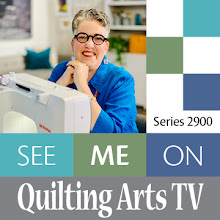Hooray! I’ve finished fusing down all of the pieces in “Passion Flower,” and I’m ready to start thread sketching. There are a lot of details and shading to be added with thread. The photo above shows how the piece looks right now; the shot below shows it under the positioning overlay.
This is one of two projects I’m designing to teach at my retreat October 4-7 in Black Mountain, NC.
One of the trickiest parts of this piece was the many small “radial filaments” (the purple squiggly things that radiate out from the area in the center (which contains three stigmas and 5 anthers). When researching this plant, I discovered that the passion flower may have been named after the passion of Christ in Christian theology. The numbers of things in this species were said to represent specific things in Christianity (10 petals representing the 10 apostles, excluding Peter – the denier – and Judas Iscariot – the betrayer; three stigmas representing the three nails with which Jesus was nailed to the cross, etc.) Interesting.
The radial filaments will get a good deal of thread work on them to add the white striations you can see in the photo on which this piece is based:
As you can see if you compare my piece to this photo, I took some artistic license, and changed some of the details. First, I made the color of the flower and buds more pink than purple. I wanted the color to be brighter. I left out the green foliage in the upper left corner, simplified some of the leaves below, and made the sky bluer.
There are two buds in the photo; I made the one in the lower right pinker, because I thought that the bright pink color helped move the eye around the piece better. And odd numbers are usually more dynamic in a composition than even ones.
I also chose to do the buds and vines in a very bright chartreuse, so that they stood out better against the background.
In the next few days, I hope to have some of the thread sketching done; I’ll share my progress here as it moves along.



















































